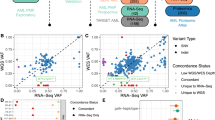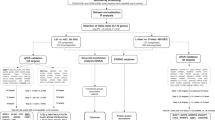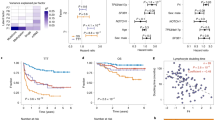Abstract
The use of the tyrosine kinase inhibitor imatinib, which blocks the enzymatic action of the BCR–ABL fusion protein, has represented a critical advance in chronic myeloid leukemia (CML) treatment. However, a subset of patients initially fails to respond to this treatment. Use of complementary DNA (cDNA) microarray expression profiling allows the identification of genes whose expression is associated with imatinib resistance. Thirty-two CML bone marrow samples, collected before imatinib treatment, were hybridized to a cDNA microarray containing 6500 cancer genes, and analyzed using bootstrap statistics. Patients refractory to interferon-α treatment were evaluated for cytogenetic and molecular responses for a minimum of 12 months. A set of 46 genes was differentially expressed in imatinib responders and non-responders. This set includes genes involved in cell adhesion (TNC and SCAM-1), drug metabolism (cyclooxygenase 1), protein tyrosine kinases and phosphatases (BTK and PTPN22). A six-gene prediction model was constructed, which was capable of distinguishing cytogenetic response with an accuracy of 80%. This study identifies a set of genes that may be involved in primary resistance to imatinib, suggesting BCR–ABL-independent mechanisms.
This is a preview of subscription content, access via your institution
Access options
Subscribe to this journal
Receive 12 print issues and online access
$259.00 per year
only $21.58 per issue
Buy this article
- Purchase on Springer Link
- Instant access to full article PDF
Prices may be subject to local taxes which are calculated during checkout


Similar content being viewed by others
References
Druker BJ, Tamura S, Buchdunger E, Ohno S, Segal GM, Fanning S et al. Effects of a selective inhibitor of the Abl tyrosine kinase on the growth of Bcr–Abl positive cells. Nat Med 1996; 2: 561–566.
Hughes TP, Kaeda J, Branford S, Rudzki Z, Hochhaus A, Hensley ML et al. Frequency of major molecular responses to imatinib or interferon alfa plus cytarabine in newly diagnosed chronic myeloid leukemia. N Engl J Med 2003; 349: 1423–1432.
Kantarjian HM, Cortes JE, O'Brien S, Luthra R, Giles F, Verstovsek S et al. Long-term survival benefit and improved complete cytogenetic and molecular response rates with imatinib mesylate in Philadelphia chromosome-positive chronic-phase chronic myeloid leukemia after failure of interferon-α. Blood 2004; 104: 1979–1988.
O'Dwyer ME, Mauro MJ, Blasdel C, Farnsworth M, Kurilik G, Hsieh YC et al. Clonal evolution and lack of cytogenetic response are adverse prognostic factors for hematologic relapse of chronic phase CML patients treated with imatinib mesylate. Blood 2004; 103: 451–455.
Shah NP, Nicoll JM, Nagar B, Gorre ME, Paquette RL, Kuriyan J et al. Multiple BCR–ABL kinase domain mutations confer polyclonal resistance to the tyrosine kinase inhibitor imatinib (STI571) in chronic phase and blast crisis chronic myeloid leukemia. Cancer Cell 2002; 2: 117–125.
Gorre ME, Mohammed M, Ellwood K, Hsu N, Paquette R, Rao PN et al. Clinical resistance to STI-571 cancer therapy caused by BCR–ABL gene mutation or amplification. Science 2001; 293: 876–880.
Branford S, Rudzki Z, Walsh S, Grigg A, Arthur C, Taylor K et al. High frequency of point mutations clustered within the adenosine triphosphate-binding region of BCR/ABL in patients with chronic myeloid leukemia or Ph-positive acute lymphoblastic leukemia who develop imatinib (STI571) resistance. Blood 2002; 99: 3472–3475.
Hochhaus A, Kreil S, Corbin AS, La Rosee P, Muller MC, Lahaye T et al. Molecular and chromosomal mechanisms of resistance to imatinib (STI571) therapy. Leukemia 2002; 16: 2190–2196.
Mahon FX, Belloc F, Lagarde V, Chollet C, Moreau-Gaudry F, Reiffers J et al. MDR1 gene overexpression confers resistance to imatinib mesylate in leukemia cell line models. Blood 2003; 101: 2368–2373.
Donato NJ, Wu JY, Stapley J, Gallick G, Lin H, Arlinghaus R et al. BCR-ABL independence and LYN kinase overexpression in chronic myelogenous leukemia cells selected for resistance to STI571. Blood 2003; 101: 690–698.
Donato NJ, Wu JY, Stapley J, Lin H, Arlinghaus R, Aggarwal BB et al. Imatinib mesylate resistance through BCR–ABL independence in chronic myelogenous leukemia. Cancer Res 2004; 64: 672–677.
Gatto S, Scappini B, Pham L, Onida F, Milella M, Ball G et al. The proteasome inhibitor PS-341 inhibits growth and induces apoptosis in Bcr/Abl-positive cell lines sensitive and resistant to imatinib mesylate. Haematologica 2003; 88: 853–863.
Tracey L, Villuendas R, Dotor AM, Spiteri I, Ortiz P, Garcia JF et al. Mycosis fungoides shows concurrent deregulation of multiple genes involved in the TNF signaling pathway: an expression profile study. Blood 2003; 102: 1042–1050.
Tracey L, Villuendas R, Ortiz P, Dopazo A, Spiteri I, Lombardia L et al. Identification of genes involved in resistance to interferon-alpha in cutaneous T-cell lymphoma. Am J Pathol 2002; 161: 1825–1837.
Harrell F . Resampling, validating, describing, and simplifying the model. In: Regression Modeling Strategies with Applications to Linear Models, Logistic Regression, and Survival Analysis. Springer: New York, 2002, pp 87–103.
Tipping AJ, Deininger MW, Goldman JM, Melo JV . Comparative gene expression profile of chronic myeloid leukemia cells innately resistant to imatinib mesylate. Exp Hematol 2003; 31: 1073–1080.
Hofmann WK, de Vos S, Elashoff D, Gschaidmeier H, Hoelzer D, Koeffler HP et al. Relation between resistance of Philadelphia-chromosome-positive acute lymphoblastic leukaemia to the tyrosine kinase inhibitor STI571 and gene-expression profiles: a gene-expression study. Lancet 2002; 359: 481–486.
Schultheis B, Carapeti-Marootian M, Hochhaus A, Weisser A, Goldman JM, Melo JV . Overexpression of SOCS-2 in advanced stages of chronic myeloid leukemia: possible inadequacy of a negative feedback mechanism. Blood 2002; 99: 1766–1775.
Kantarjian H, Sawyers C, Hochhaus A, Guilhot F, Schiffer C, Gambacorti-Passerini C et al. Hematologic and cytogenetic responses to imatinib mesylate in chronic myelogenous leukemia. N Engl J Med 2002; 346: 645–652.
Kantarjian H, Talpaz M, O'Brien S, Garcia-Manero G, Verstovsek S, Giles F et al. High-dose imatinib mesylate therapy in newly diagnosed Philadelphia chromosome-positive chronic phase chronic myeloid leukemia. Blood 2004; 103: 2873–2878.
Kantarjian HM, O'Brien S, Cortes JE, Shan J, Giles FJ, Rios MB et al. Complete cytogenetic and molecular responses to interferon-alpha-based therapy for chronic myelogenous leukemia are associated with excellent long-term prognosis. Cancer 2003; 97: 1033–1041.
Gordon MY, Dowding CR, Riley GP, Goldman JM, Greaves MF . Altered adhesive interactions with marrow stroma of haematopoietic progenitor cells in chronic myeloid leukaemia. Nature 1987; 328: 342–344.
Ramaraj P, Singh H, Niu N, Chu S, Holtz M, Yee JK et al. Effect of mutational inactivation of tyrosine kinase activity on BCR/ABL-induced abnormalities in cell growth and adhesion in human hematopoietic progenitors. Cancer Res 2004; 64: 5322–5331.
McLean LA, Gathmann I, Capdeville R, Polymeropoulos MH, Dressman M . Pharmacogenomic analysis of cytogenetic response in chronic myeloid leukemia patients treated with imatinib. Clin Cancer Res 2004; 10: 155–165.
Wertheim JA, Forsythe K, Druker BJ, Hammer D, Boettiger D, Pear WS . BCR–ABL-induced adhesion defects are tyrosine kinase-independent. Blood 2002; 99: 4122–4130.
Fruehauf S, Topaly J, Schad M, Paschka P, Gschaidmeier H, Zeller WJ et al. Imatinib restores expression of CD62L in BCR–ABL-positive cells. J Leukoc Biol 2003; 73: 600–603.
Pelletier SD, Hong DS, Hu Y, Liu Y, Li S . Lack of the adhesion molecules P-selectin and intercellular adhesion molecule-1 accelerate the development of BCR/ABL-induced chronic myeloid leukemia-like myeloproliferative disease in mice. Blood 2004; 104: 2163–2171.
Cohen N, Rozenfeld-Granot G, Hardan I, Brok-Simoni F, Amariglio N, Rechavi G et al. Subgroup of patients with Philadelphia-positive chronic myelogenous leukemia characterized by a deletion of 9q proximal to ABL gene: expression profiling, resistance to interferon therapy, and poor prognosis. Cancer Genet Cytogenet 2001; 128: 114–119.
Huntly BJ, Guilhot F, Reid AG, Vassiliou G, Hennig E, Franke C et al. Imatinib improves but may not fully reverse the poor prognosis of patients with CML with derivative chromosome 9 deletions. Blood 2003; 102: 2205–2212.
Quintas-Cardama A, Kantarjian H, Talpaz M, O'Brien S, Garcia-Manero G, Verstovsek S et al. Imatinib mesylate therapy may overcome the poor prognostic significance of deletions of derivative chromosome 9 in patients with chronic myelogenous leukemia. Blood 2005; 105: 2281–2286.
Tergaonkar V, Pando M, Vafa O, Wahl G, Verma I . p53 stabilization is decreased upon NFkappaB activation: a role for NFkappaB in acquisition of resistance to chemotherapy. Cancer Cell 2002; 1: 493–503.
Brandes LM, Lin ZP, Patierno SR, Kennedy KA . Reversal of physiological stress-induced resistance to topoisomerase II inhibitors using an inducible phosphorylation site-deficient mutant of I kappa B alpha. Mol Pharmacol 2001; 60: 559–567.
Dai Y, Rahmani M, Pei XY, Dent P, Grant S . Bortezomib and flavopiridol interact synergistically to induce apoptosis in chronic myeloid leukemia cells resistant to imatinib mesylate through both Bcr/Abl-dependent and -independent mechanisms. Blood 2004; 104: 509–518.
Schimmer AD, Welsh K, Pinilla C, Wang Z, Krajewska M, Bonneau MJ et al. Small-molecule antagonists of apoptosis suppressor XIAP exhibit broad antitumor activity. Cancer Cell 2004; 5: 25–35.
Cohen S, Dadi H, Shaoul E, Sharfe N, Roifman CM . Cloning and characterization of a lymphoid-specific, inducible human protein tyrosine phosphatase, Lyp. Blood 1999; 93: 2013–2024.
Chien W, Tidow N, Williamson EA, Shih LY, Krug U, Kettenbach A et al. Characterization of a myeloid tyrosine phosphatase, Lyp, and its role in the Bcr–Abl signal transduction pathway. J Biol Chem 2003; 278: 27413–27420.
Zheng XM, Wang Y, Pallen CJ . Cell transformation and activation of pp60c-src by overexpression of a protein tyrosine phosphatase. Nature 1992; 359: 336–339.
Lewis DF . 57 varieties: the human cytochromes P450. Pharmacogenomics 2004; 5: 305–318.
Williams CS, Mann M, DuBois RN . The role of cyclooxygenases in inflammation, cancer, and development. Oncogene 1999; 18: 7908–7916.
Crossman LC, Mori M, Hsieh YC, Lange T, Paschka P, Harrington CA et al. In chronic myeloid leukemia white cells from cytogenetic responders and non-responders to imatinib have very similar gene expression signatures. Haematologica 2005; 90: 459–464.
Kaneta Y, Kagami Y, Katagiri T, Tsunoda T, Jin-nai I, Taguchi H et al. Prediction of sensitivity to STI571 among chronic myeloid leukemia patients by genome-wide cDNA microarray analysis. Jpn J Cancer Res 2002; 93: 849–856.
Acknowledgements
We thank A Schirenbeck, M Casanova, A Swat and A Greninger for their invaluable help with the reading and analysis of microarrays. We also thank M Navarrete and P de la Cueva for their help with the molecular techniques. We are also grateful to the members of the Departments of Hematology, Cytogenetics and Molecular Biology of the Hospital de la Princesa, the Hospital Ramón y Cajal from Madrid and Hospital Virgen de la Salud, Toledo, especially M Santos-Roncero, E Tejera and E Arranz, for their help with clinical follow-up and samples. We also thank the Tumour Bank Network of the Spanish National Cancer Centre.This work was supported by grants from the Ministerio de Educación y Ciencia (SAF2001-0060 and SAF2004-04286) and from the Ministerio de Sanidad y Consumo (G03/179 and PI052316), Spain, and from NOVARTIS FARMACEUTICA, SA.
Author information
Authors and Affiliations
Corresponding author
Additional information
Supplementary Information accompanies the paper on the Leukemia website (http://www.nature.com/leu)
Rights and permissions
About this article
Cite this article
Villuendas, R., Steegmann, J., Pollán, M. et al. Identification of genes involved in imatinib resistance in CML: a gene-expression profiling approach. Leukemia 20, 1047–1054 (2006). https://doi.org/10.1038/sj.leu.2404197
Received:
Revised:
Accepted:
Published:
Issue Date:
DOI: https://doi.org/10.1038/sj.leu.2404197
Keywords
This article is cited by
-
EVI1 upregulates PTGS1 (COX1) and decreases the action of tyrosine kinase inhibitors (TKIs) in chronic myeloid leukemia cells
International Journal of Hematology (2023)
-
Exome, transcriptome and miRNA analysis don’t reveal any molecular markers of TKI efficacy in primary CML patients
BMC Medical Genomics (2019)
-
Functional polymorphism of CYP2B6 G15631T is associated with hematologic and cytogenetic response in chronic myeloid leukemia patients treated with imatinib
Medical Oncology (2014)
-
Effect of interaction of glutathione S-transferases (T1 and M1) on the hematologic and cytogenetic responses in chronic myeloid leukemia patients treated with imatinib
Medical Oncology (2014)
-
Gene expression profiling of chronic myeloid leukemia with variant t(9;22) reveals a different signature from cases with classic translocation
Molecular Cancer (2013)



